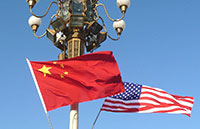Yuan drops again as rate adjustment continues
By Chen Jia (China Daily/Agencies) Updated: 2015-08-13 07:09
 |
|
A Chinese clerk counts RMB (renminbi) yuan banknotes at a bank in Huaibei city, East China's Anhui province, January 22, 2015. [Photo/IC] |
Stocks, the US dollar, and emerging market currencies around the world remained under pressure for a second day on Wednesday after China's yuan weakened again, a day after the country devalued its currency.
Major Wall Street averages pared losses by late afternoon, however, as Apple and energy shares reversed direction to trade higher.
The Dow Jones industrial average fell 0.33 points to end barely changed at 17,402.51, the S&P 500 rose 1.98 points, or 0.1 percent, to 2,086.05 and the Nasdaq Composite added 7.59 points, or 0.15 percent, to 5,044.39.
The US dollar weakened against most major currencies, with US debt yields lower also, as investors questioned whether China's devaluation would affect the Federal Reserve's plans to raise interest rates later this year.
US Treasury debt prices rose on Wednesday, with yields on benchmark 10-year notes brushing a three-month low. Those gains were pared as stocks recovered, however, with the yield at 2.15 percent, about even with the previous day.
The dollar recovered some of the day's losses, but was still down against other currencies. The euro rose 1.1 percent, breaching $1.11 for the first time in three weeks and the US dollar fell 0.7 percent against the yen to 124.19 yen.
The value of the Chinese yuan fell by an additional 1.6 percent on Wednesday, continuing a dramatic slide prompted by the central bank's cut in the reference rate against the US dollar.
The People's Bank of China reduced the yuan's reference rate to 6.3306 yuan per dollar on Wednesday, following a reduction on Tuesday of 1.86 percent-the largest single-day drop in 21 years.
On Wednesday, the yuan's onshore trading price declined by 2 percent to a four-year low of 6.4465, according to the China Foreign Exchange Trade System.
A central bank adviser explained that the bank has made a "one-off move" by introducing a new exchange system.
"Whether the currency will rise or fall will be determined more by the market," said Huang Yiping, a monetary policy adviser for the People's Bank of China.
The bank said it would base the rate on a market maker quote system, taking into consideration the previous trading day's closing price, the movements of the world's major currencies, and the demand and supply of yuan in the market.
Effects of the yuan's devaluation continued to reverberate around the globe on Wednesday, with Asian stocks falling to a seven-month low and major European indexes dropping as investors speculated that the weakened yuan will sap China's demand for commodities.
"There is no economic basis for a continuous fall of the yuan, since the macroeconomic environment is still sound and stable," said a statement on the central bank's website.
"The exchange rate fluctuation is normal, and it can better reflect market expectations," it said.
Huang told China Daily that freeing up the yuan's exchange rate is significant for deepening financial reform, and he said it will prevent huge fluctuations in cross-border capital flows.
"The government is expected to introduce more measures toward that goal in the second half of this year."
The central bank's move gained praise from the International Monetary Fund, which said the new pricing regime "appears a welcome step as it should allow market forces to have a greater role in determining the exchange rate".
Economists predicted that the depreciation will reduce China's imports while boosting its exports.
Eddie Cheung, an Asia foreign exchange strategist at Standard Chartered Bank (HK) Ltd, said that "the PBOC is likely to have to intervene to smooth sharp fluctuations, though increased volatility in the yuan is likely".
- 2015 China International Fair for Investment and Trade kicks off in Xiamen
- China's commodity imports robust in Jan-Aug period
- China stocks rebound 2.92%
- 2015 China box office already past 2014 total
- China foreign trade decline widens in August
- Interview: JP Morgan's senior executive bullish on China
- Innovation, development the focus for NZ mayors
- Lives of freelancers

















